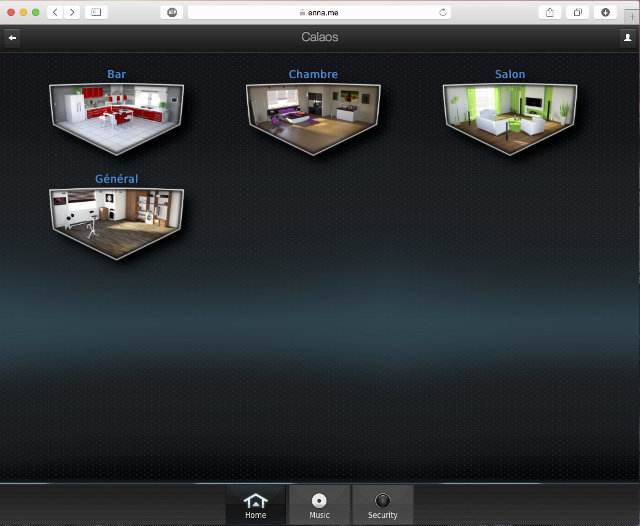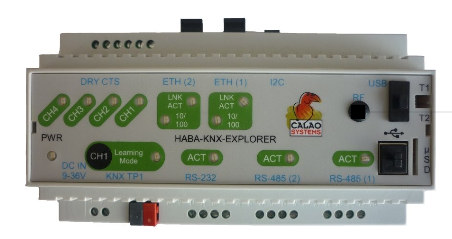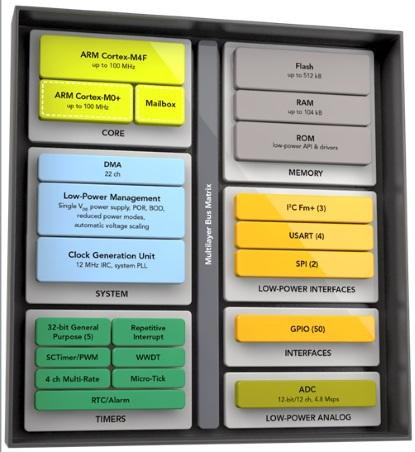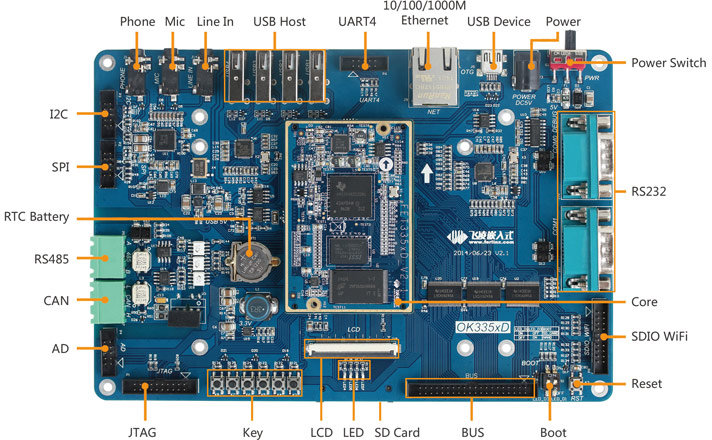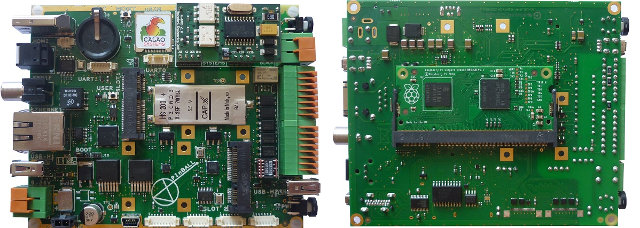Calaos is a Linux based home automation software released under GPLv3 license that works on Raspberry Pi, some Allwinner platforms like Cubiebaord 1/2, Mele A1000(G)/A2000, as well as x86 / amd64 hardware platforms that allows you control switches & lights in the rooms of your home or office, control your music, and manage security cameras.. The developers have recently released Calaos v2.0, the first stable release, so it’s a good time to have a look. The software stack is comprised of 6 main components: Calaos Server – Daemon that exports the state of the house via a JSON protocol. It can currently manage the following hardware components and protocols: Wago’s PLC, with digital or analog I/O, DALI or DMX light bus IPX800 web relay board GCE Electronics Eco Devices used to monitor power consumption. Web API 1-Wire, X10 Zibase I/O GPIO (Linux based GPIO, for direct use of RaspberryPI GPIO […]
Calao Systems Introduces Linux based DIN Rail Home and Building Automation Systems
Calao Systems is an embedded systems company that I came to know thanks to their Snowball development boards based on the now defunct ST Ericsson Nova A9500 processor. The company has now launched new products for building and home automation powered by Atmel AT91SAM9G20 ARM9 processor clocked at 400 MHz housed in a DIN Rail enclosure. Two products are now available HABA-KNX-EXPLORER and HABA-KNX-LITE that share the following specifications: Processor – Atmel ARM926EJ-S @ 400MHz System Memory – 128MB SDRAM Storage – 256MB NAND Flash, 16 Mbit serial flash, 2Kbit EEPROM with MAC address, and Micro SD slot Connectivity Lite – 1x Ethernet 10/100Mbits Explorer – 2x Ethernet 10/100Mbits USB – 2x USB Host FS (12Mbits), 1x USB Device FS (12Mbits) Serial (Explorer only) – 1x RS-232 (isolated), 2x RS-485 (isolated) Automation I/F – 1x KNX/TP1 (isolated) Expansion – 1x RF Expansion Connector Debugging – JTAG and DBGU interfaces Misc […]
Linaro Connect Hong Kong 2015 Schedule and Demos
Linaro Connect Hong Kong 2015 will take place on February 9 – 13,2015 in Hong Kong, and the organization has released the schedule for the five days events with keynotes, sessions, and demos. Each day will start with the keynote including speakers such as: George Grey, Linaro CEO, who will welcome attendees to Linaro Connect, and provide an update on the latest Linaro developments Jon Masters, Chief ARM Architect, Redhat, who will present Red Hat update and latest ARMv8-A demonstrations Dejan Milojicic, Senior Researcher & Manager, HP Labs Bob Monkman, Enterprise Segment Marketing Manager, ARM, will discuss about the impact of ARM in next generation cloud and communication network infrastructure Greg Kroah-Hartman, Linux Foundation Fellow, will introduce the Greybus Project (Linux for Project Ara modular phones) Warren Rehman, Android Partner Engineering Manager, Google The agenda also features sessions covering Android, ARMv8-A, Automation & Validation, Digital Home, Enterprise Servers, LAVA, Linux […]
Snappy Ubuntu Core is an IoT Linux Distribution for ARM and x86
Canonical has announced a version of Ubuntu specifically designed for IoT devices running Linux, with a low hardware requirements, and a new package manager called snappy, replacing apt-get for this version of Ubuntu, which provides simpler, faster, and more reliable updates, stronger security, and allows roll-backs in case something goes wrong. Easy firmware updates are something missing in most connected device, which means they are more vulnerable to potential hackers, but with snappy security updates should be able to make it regularly, so that if something like heartbleed occurs again, you know your router, home automation gateway, connected washing machine, or robot will be soon patched automatically. Let’s go through the hardware requirements first: Processor – 600 MHz processor (ARMv7 or greater, or x86) System Memory – 128 MB RAM or greater (The system itself uses 40 MB RAM) Storage – 4GB flash / storage for factory reset and system […]
Crowdfunding Report for 2014 on CNX Software Blog
Following up on my 2013 Crowdfunding Report, I’ve gone through all 55 Kickstarter and Indiegogo crowdunding projects featured on CNX Software between December 2013 and November 2014 (inclusive) to see how well they fared. The table below sort projects chronologically as they were published on this very blog. Date Project Crowdfunding Site Funded? Pledged amount / Goal Expected Delivery Actual Delivery Comments 2. Dec. 2013 Micro Python Kickstarter Yes 97,803 GBP / 15,000 GBP 03/2014 04/2014 Available @ https://micropython.org/store/#/store 5. Dec. 2013 Plugaway Kickstarter Yes $162,835 AUD / $50,000 AUD 04/2014 – People upset because of lack of updates. Project might be dead, and backers lost their money 6. Dec. 2013 AIRTAME Indiegogo Yes $1,268,332 / $160,000 05/2014 12/2014 People have started received the beta versions, after a massive 8-month delay 7. Dec. 2013 Crystal Board Kickstarter No $14,574 / $200,000 04/2014 – The project appears to be dead 10. […]
NXP Introduces LPC54100 Single & Dual Core Cortex M4F/M0+ MCU Family and LPCXpresso54102 Development Kit
NXP has recently introduced LPC54100 Series microcontrollers with a Cortex-M4F core up to 100MHz, and optionally an ARM Cortex M0+ core for always-on sensor processing applications, as well as LPCXpresso 54102 board. Typical applications include mobile, portable health and fitness, home and building automation, fleet management and asset tracking, robotics and gaming. Key features of LPC54100 series MCUs: CPU – 32-bit ARM Cortex-M4F up to 100 MHz, optional 32-bit ARM Cortex-M0+ coprocessor On-chip RAM – 104 KB internal RAM On-chip Storage – Up to 512 KB on-chip Flash Interfaces 3 fast-mode plus I²C, 4 UART, 2 SPI, 39 GPIO ADC with up to 12-channels, 12 bits, and 4.8 Msps sample rate, full-spec (1.62 V to 3.6 V) Clock Sources – IRC, digital clock input, PLL, 32 kHz XTAL, WWDT Timers – 5x 32-bit general-purpose timers/counters, One-state configurable timer/PWM, RTC with alarm, and WWDT 22-channel DMA with 20-programmable triggers Power consumption […]
Forlinx OK335xD Industrial Single Board Computer Supports Android, Linux and WinCE
Forlinx, an embedded systems design and manufacturing company based in Hebei province in China, has announced OK335xD industrial (temperature) single board computer powered by Texas Instruments Sitara AM335X processor, and which appears to be a high-end version of their OK335xS-II SBC with more ports. Potential applications include communication devices, medical equipment, automotive computers, control panels, data acquisition devices, industrial control, industrial automation equipment, and more. OK335xD single board computer is composed of a CPU module (FET335xD), and a baseboard simply called “OK335xD Base Board”. Listed specifications for FET335xD computer-on-module: SoC – Texas Instruments Sitara AM3354 Cortex A8 processor @ 800MHz with PowerVR SGX530 GPU System Memory – 512MB DDR3 Storage – 256MB SLC NAND Flash Interfaces available via CoM connector: 1x USB 2.0 Host; 1x USB2.0 OTG Ethernet Dual Gigabit Ethernet 3x MMC 3x I2C, 2x SPI, 6x UART / IrDA Various GPIO pins 8x ADC 2x CAN LCD Interface […]
CALAO Systems Introduces PInBALL Industrial Board Based on Raspberry Pi Compute Module
CALAO Systems has just launched an industrial single board computer (SBC) for professional Raspberry Pi developers called PiNBALL or, if you prefer, PAC-1210-S200-B2835-EXX…. The board is powered by the Raspberry Pi Compute Module, features interfaces such as two mini PCIe slots (for USB, I2C, GPIOs,…), fast Ethernet, HDMI, opto-isolated inputs and outputs, etc., +6 to +36V power input, and can operate in -20°C to +70°C temperature range. PInBALL industrial SBC specifications (Items marker with ‘*’ are optional, and depend on model): SoC / Memory / Storage – Via Raspberry Pi Compute Module – Broadcom BCM2835, 512MB RAM, 4GB eMMC Flash. Other Storage – 1x 2Kb I²C EEPROM with EUI-48 MAC Address & 128 bit Serial Number (AT24MAC402). Video Output – 1x HDMI Out, 1x CVBS Out (BCM2835) Audio Output – 1x HDMI, 2x S/PDIF Out / Optical & RCA (WM8804), Connectivity – 1x Fast Ethernet (LAN9514), 1x Micro-SIM Socket USB […]


